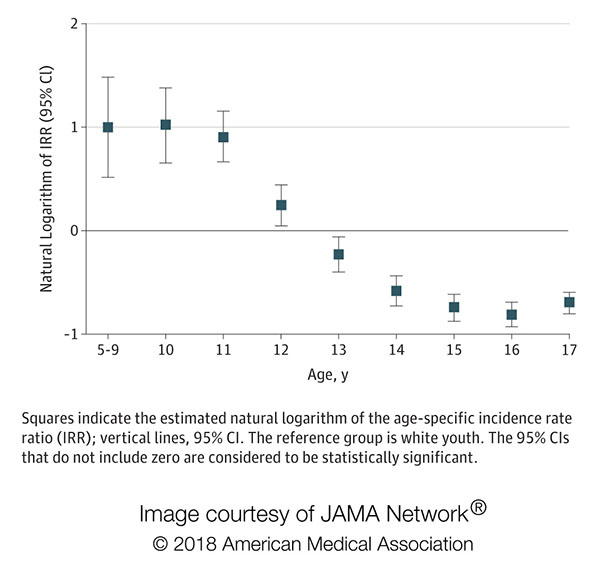Archived Content
The National Institute of Mental Health archives materials that are over 4 years old and no longer being updated. The content on this page is provided for historical reference purposes only and may not reflect current knowledge or information.
Age-Related Racial Disparity in Suicide Rates Among U.S. Youth
NIH-funded study suggests need for more research into contributing factors; targeted interventions for children
• Press Release
New research suggests the suicide rate is roughly two times higher for black children ages 5-12 compared with white children of the same age group. The study, funded by the National Institute of Mental Health (NIMH), appears online May 21 in JAMA Pediatrics.
Suicide is a major public health problem and a leading cause of death in the United States. While suicide among young children is quite rare, it can be devastating to families, friends, and communities. Past patterns of national youth suicide rates revealed higher rates for white compared to black youth.
Jeffrey Bridge, Ph.D., of the Research Institute at Nationwide Children’s Hospital, Columbus, Ohio, Lisa Horowitz, Ph.D., of the NIMH Intramural Research Program, and coauthors set out to investigate race-related differences in suicide rates in youth overall. Using data from the Centers for Disease Control and Prevention’s Web-based Injury Statistics Query and Reporting System (WISQARS) , which provides fatal and nonfatal injury, violent death, and cost-of-injury data, the team of researchers analyzed the data from 2001-2015 separately for children ages 5-12 and adolescents ages 13-17.
The findings suggest the suicide rate is roughly two times higher for black children compared with white children of the same age group. These results were observed in both males and females. In contrast, the rate of suicide for black adolescents was half that of white adolescents; these results held when the data were analyzed by sex.
“While the suicide rate was lower for black youth than white youth overall, we found a striking change in that trend when we analyzed the suicide rates by the two age groups,” explained Horowitz.
Although the researchers were able to examine suicide rates, the data did not include information on what might be contributing to age-related racial disparities in suicide. Researchers noted that while the data are limited, the findings highlight the need for a greater understanding of the extent of age-related racial disparities in youth suicide. More research is needed to examine the factors that may have contributed to the disparity, such as the impact of accessible healthcare and homicide victimization.
“Gaining an understanding of these and other contributing factors may someday lead to targeted, culturally sensitive interventions and help reverse the trend in suicide rates in the U.S.,” concluded Horowitz.

Reference
Bridge, J.A., Horowitz, L.M., Fontanella, C.A., Sheftall, A.H., Greenhouse, J.B., Kelleher, K.J., Campo, J.V. (2018). Age-related racial disparity in suicide rates among U.S. youths between 2001 and 2015. JAMA Pediatrics.
Grants
About the National Institute of Mental Health (NIMH): The mission of the NIMH is to transform the understanding and treatment of mental illnesses through basic and clinical research, paving the way for prevention, recovery and cure. For more information, visit the NIMH website.
About the National Institutes of Health (NIH): NIH, the nation's medical research agency, includes 27 Institutes and Centers and is a component of the U.S. Department of Health and Human Services. NIH is the primary federal agency conducting and supporting basic, clinical, and translational medical research, and is investigating the causes, treatments, and cures for both common and rare diseases. For more information about NIH and its programs, visit the NIH website .
NIH…Turning Discovery Into Health®
